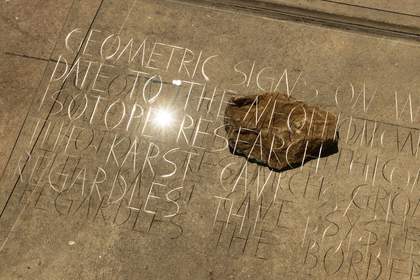Using video, light, glass and text, Daučíková creates a space where the self does not rely on secure, fixed notions of identity
Since the 1970s, Daučíková’s works have explored the idea of ‘in-betweenness’ as a queer state of being. They create a gestural, bodily language made up of ‘speaking hands, hips, ears, feet in all their reappearances’ to live out Daučíková’s transgender identity,
which the artist calls ‘the mental body’.
In Expedition for Four Hands and Accompaniment, two pairs of hands, ambiguous in gender, perform the actions of cutting glass and folding cloth. They come together to perform a gestural dance against the dark depths of a cave. There, Daučíková’s glass sculptures are briefly and partly visible in moving light. Poetic proclamations by the artist punctuate the imagery.
Daučíková has a longstanding interest in the properties of glass to reflect, distort and shift between the material and immaterial. The artist has also placed glass sheets across the space. Some rest on stones taken from the cave shown in the video. Others reflect the projection onto the floor and walls, conjuring a hallucinatory space of fluidity and disorientation.
Daučíková’s resolve to create ‘a positive state of instability’ is grounded in a political commitment to global LGBTQIA+ rights. Several sheets include writing scratched with a titanium tool, featuring poetic expressions, quotations, and references to the number of transgender people killed in transphobic attacks between 2000 and 2019, the year the work was made. Through passages in a newspaper-style publication placed in the space, the work is dedicated to Zak Kostopoulos (1985–2018), an LGBTQIA+ rights activist and drag performer murdered in Greece in 2018.

